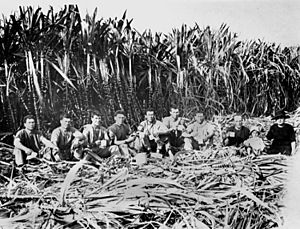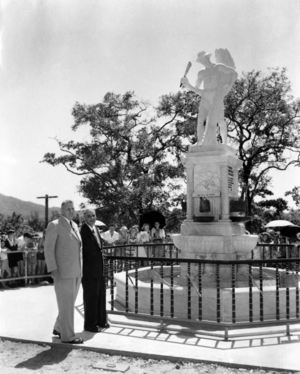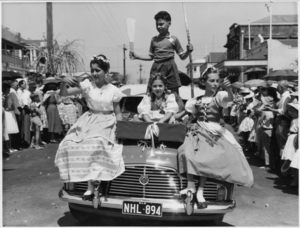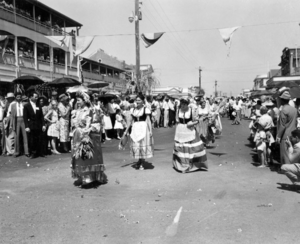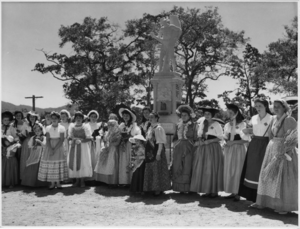Canecutters Memorial facts for kids
Quick facts for kids Canecutters Memorial |
|
|---|---|
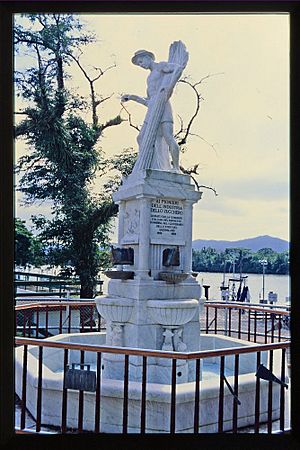
Canecutters Memorial, 1999
|
|
| Location | Fitzgerald Esplanade, Innisfail, Cassowary Coast Region, Queensland, Australia |
| Design period | 1940s - 1960s (post-World War II) |
| Built | 1959 |
| Architect | Renato Beretta |
| Official name: Canecutters Memorial, Pioneers of the Sugar Industry Monument | |
| Type | state heritage (built) |
| Designated | 29 April 2003 |
| Reference no. | 602041 |
| Significant period | 1950s (fabric) |
| Significant components | statue, fence/wall - perimeter, memorial - fountain |
| Lua error in Module:Location_map at line 420: attempt to index field 'wikibase' (a nil value). | |
The Canecutters Memorial is a special monument located in Innisfail. It's a heritage-listed memorial that honors the people who worked hard in the sugarcane fields. The memorial was designed by Renato Beretta and built in 1959. It's also known as the Pioneers of the Sugar Industry Monument. This important site was added to the Queensland Heritage Register on April 29, 2003.
Contents
History of the Canecutters Memorial
The Canecutter's Memorial was built in 1959 by the Italian community living in the Innisfail area. They wanted to celebrate Queensland's 100th birthday as a state. They chose a life-size statue of a canecutter because growing sugarcane was super important for the area's economy and jobs.
Early Days of Innisfail
The town of Innisfail was first called Geraldton until 1911. It was started in 1880 by Thomas Henry Fitzgerald. He arrived with 35 workers from the South Sea Islands and ten Irish workers. Their goal was to grow sugarcane on a huge piece of land. This project was supported by the Catholic Church. More people soon arrived, and the community grew. Their main way of making money was by producing sugar. A sugar mill was built nearby in Mourilyan in 1882, and another one opened in South Johnstone in 1915.
Sugarcane and Workers
Sugarcane was first grown for business in Queensland in 1864. At first, large farms used workers from the South Sea Islands. People thought that working in the hot Queensland cane fields was too hard and unhealthy for European workers.
However, things started to change in the 1880s and 1890s. The Queensland Government began a plan to send South Sea Islanders back to their homes. Sugarcane growers then looked for workers from warmer parts of Europe, like Italy. They believed these workers would be better suited for the climate.
The first Italians arrived in North Queensland in Townsville in 1891. A few moved to the Johnstone area in the 1890s, but they were mostly farmers, not laborers. The first large group of Italian workers looking for cane-cutting jobs arrived around 1907-1908. These Italian migrants were known for being very determined. They were willing to work hard even in tough conditions. Many of them eventually saved enough money to buy their own farms.
Italian Immigration Waves
Many Italians came to North Queensland before World War I. But Italian immigration really grew after the war. Life in Italy was difficult then, so many people looked for a new start in other countries. Australia became a popular choice in the 1920s, especially after the United States limited immigration from Italy.
The Australian and Italian Governments agreed on a system where Italians already living in Australia could invite their relatives and friends to join them. This led to many family groups settling together. The strong Italian community in Innisfail became even stronger with these new arrivals.
Another big wave of Italian migrants came after World War II. People from many European countries, including Italy, arrived in Australia as people who had to leave their homes because of the war. They were given contracts to work in the cane fields. Italians were the largest group among these migrants who worked in the sugar industry. They continued to play a huge part in the sugar-growing communities of North Queensland, including Innisfail.
Building the Memorial
In 1959, the Queensland Government suggested that communities build something lasting to celebrate 100 years since Queensland separated from New South Wales. A group from the Italian community in Innisfail decided to build a statue.
They sent photos of the sugar industry's history in the Johnstone area to an artist in Sydney named Lamberto Yonna. He suggested a statue of a canecutter. The committee in charge of the project wrote to Carrara, Italy, asking sculptors to send their designs. They chose the design by Renato Beretta, who was an instructor at the Carrara Academy of Arts.
The monument was made in Carrara, Italy. It arrived in Australia in 32 large boxes. An Italian migrant named P Bertolani, who had arrived just two months earlier, put it together. The leader of Queensland's government, the Hon Frank Nicklin, officially unveiled the monument on October 4, 1959. It cost about £5000 to build.
What the Memorial Looks Like
The Canecutter's Memorial is on the Innisfail Esplanade, which is a riverside walkway. It looks out over the Johnstone River at the end of Edith Street. It's in a small paved area surrounded by trees and a grassy park. The land to the east of the memorial slopes down towards the river.
The monument is made of white marble. It has an eight-sided pool with a square base (called a plinth) in the middle. This base has a water fountain and a bowl on each side. On top of the base is a life-sized statue of a man cutting cane by hand. The canecutter wears typical work clothes, like shorts and a hat. He holds a cane knife in his right hand. Under his left arm and across his back, he carries a bunch of sugarcane.
Below the statue, two sides of the base have carvings (called bas reliefs) that show canecutters at work. The front of the monument has a Latin saying: "UBI BENI IBI PATRIA." This roughly means 'Where one is content, there is one's homeland.'
The other two sides have messages, one in English and one in Italian. The English message says:
TO THE PIONEERS OF THE SUGAR INDUSTRY DONATED BY THE ITALIAN COMMUNITY OF INNISFAIL DISTRICT ON THE FIRST CENTENARY OF THE STATE OF QUEENSLAND 1859 1959
Below these panels are metal water spouts shaped like water bags. The water flows into metal bowls and then into fancy marble basins. These basins are supported by pairs of decorative dolphin shapes.
The whole monument is surrounded by an eight-sided metal fence. This fence looks like sugarcane stalks and has tram rails on top. It's also decorated with tools used in the cane-cutting trade.
Why the Memorial is Important
The Canecutters Memorial was added to the Queensland Heritage Register on April 29, 2003. This means it's recognized as a very important part of Queensland's history and culture.
Showing Queensland's History
The Canecutter's Memorial helps us understand Queensland's history. It shows how important the sugar industry was in North Queensland. For many years, Innisfail and the areas around it depended on sugar. Even today, sugar is a vital crop for the economy of the Johnstone Shire.
Since the Italian community built it, the Memorial also shows how much Italian migrants helped the sugar industry. They worked as laborers and became farm owners. The statue of a canecutter is also important because it reminds us of a time when people cut cane by hand. This job became less common in the 1960s and 1970s when machines started doing the work.
Unique Cultural Heritage
The Canecutter's Memorial is special because it's one of the early monuments in Queensland with writing in two languages: English and Italian. It was built in 1959 and is a tribute to the sugar industry's pioneers from different cultures. This was before Australia widely adopted the idea of multiculturalism later in the 20th century.
Beautiful Design
The Canecutter's Memorial is also important because it's a beautiful example of a sculptor's work. It stands in a very noticeable spot along the Innisfail Esplanade, which is a lovely park area along the Johnstone River. It also marks the end of the long view down Edith Street, which is one of the main streets in the town center.
Important to the Community
The Canecutter's Memorial is very important to the Italian community in Innisfail. They built it in 1959 to honor the pioneers of the sugar industry, many of whom were Italian. The Memorial is also important to the wider Innisfail community. It's a way to remember the people who helped build an industry that has been vital for the area's growth and success.
Images for kids


